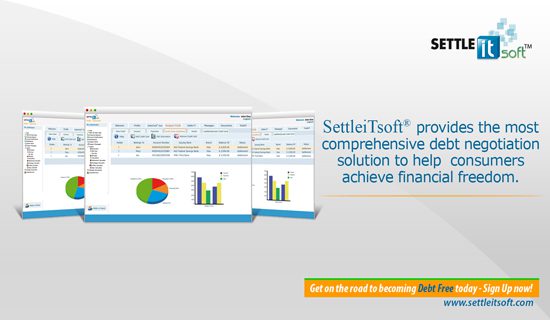Key to Debt Settlement – Gotta Save Before You Can Settle!

So, when it comes to your financial life, you’re tired of being treated like a second-class citizen. You’re fully employed again with a good salary and bills are current. But since you are months and months behind on your outstanding credit card debt, you probably can’t get a mortgage at all or car loan at a decent rate (13%! OMG!!). The solution: start debt settlement negotiation as soon as possible.
Tough Thing to Do?
 Actually, it’s a lot easier than you may think for two main reasons. One, your creditors most likely will be more than happy to work with you; particularly if you offer a sensible, verifiable repayment plan. Two, there is online software available for free at www.settleitsoft.com that provides all the calculating, negotiating and communication tools you will need to accomplish your settlement goals while staying in complete control of the process – without ever speaking to your creditors. The software platform will do that – and all the other “heavy lifting” – for you.
Actually, it’s a lot easier than you may think for two main reasons. One, your creditors most likely will be more than happy to work with you; particularly if you offer a sensible, verifiable repayment plan. Two, there is online software available for free at www.settleitsoft.com that provides all the calculating, negotiating and communication tools you will need to accomplish your settlement goals while staying in complete control of the process – without ever speaking to your creditors. The software platform will do that – and all the other “heavy lifting” – for you.
Three Basic Steps for Debt Settlement
First, enroll for free. Second, add your creditors’ information. Third, start negotiating. However, to get the most from the power and intuitive capabilities of the software platform and ultimately achieve the success desired, it is essential to utilize the conveniently built-in financial management tools – such as Budget-iTsoft – which will help you determine how much money you currently have available to deposit in a settlement savings account and create a saving plan that will help accomplish your settlement goals.
Using SettleiTsoft® to create a detailed budget which clearly defines income and outgo often exposes where and how you are wasting money you could use for other purposes, such as settlement savings. Start by organizing your expenses into the following categories: fixed, flexible and discretionary.
- Fixed expenses represent necessities whose monthly amounts typically are unchanged, such as a mortgage or rent, vehicle loan or lease payment, and insurance. Credit card payments may also be considered a fixed expense since the minimum payments usually remain the same each month.
- Flexible expenses consist of all the items that you can control or substitute for a less expensive alternative. Examples include groceries, utilities and medical bills.
- Discretionary expenses are all those non-essentials that are not required for your day-to-day survival such as magazine subscriptions, Cable or Satellite TV, or that daily cup of specialty coffee.
Now list and total all your income. In addition to wages earned, make certain to include alimony, interest earnings, dividends and any other income sources.
Once you have identified all your expenses and earnings, total your expenses and then subtract this amount from your income. Of course, your overall goal is to make more money than you spend. If your income exceeds your expenses, this amount is known as Residual Income. You may then create a plan to allocate those funds toward paying off some of your debts faster.
If your expenses surpass your income, you need to make some cuts in your spending and/or look for ways to earn additional income. Minimally, you want your earnings and expenses – including settlement saving allocation – to be equal. By doing so, you have created a financial plan that accounts for all your needs and should be easy for you to maintain.



 Login
Login






